 Indians Archive
Indians Archive  Tribe Game Vault: 7/2/70. Will Slugger Tony Horton Come Through in the Ninth?
Tribe Game Vault: 7/2/70. Will Slugger Tony Horton Come Through in the Ninth?
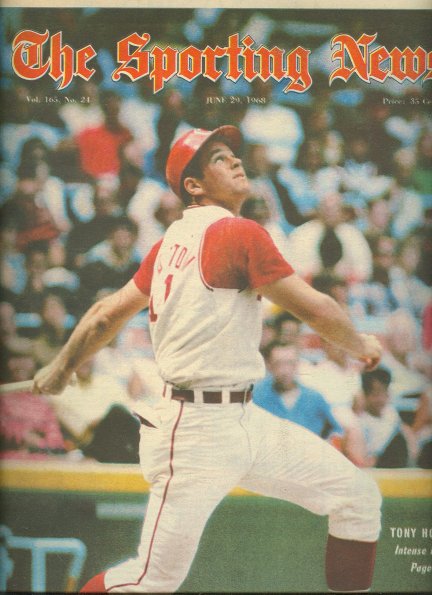
“Wait, wait- stop. Whatcha got there?” The black borders were what caught my eye.
The young boy had been flipping through his baseball card album, and the pages now lay open. Sure enough- those were 1971 Topps cards. The boy had them sorted by team, much like I did back in the day. The photos of the Cleveland Indians players were familiar, as I had collected and studied most of those cards during the winter following the 1970 season. There was Ray Fosse, the 1970 rookie catcher who hit cleanup most of the year. He was an immediate star, and would earn Indians co-Man of the Year honors with 20-game winner Sam McDowell. Duke Sims had been the previous catcher for the Tribe, and was now playing a lot of left field with the emergence of Fosse. He often hit fifth. Graig Nettles was the young third baseman. Very good glove; his bat was not fully developed although he was reliable enough to be the regular two hitter.
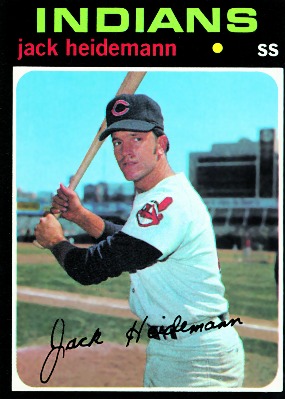 Variously leading off or hitting in the three hole for most of the season was Vada Pinson, the solid veteran who was in the twilight of his career. He had been overshadowed by teammate Frank Robinson both in high school and with the Cincinnati Reds. He played a lot of both right field and left field. Shortstop Jack Heidemann led off some; otherwise, he hit seventh. Outfielder Ted Uhlaender also hit seventh at times, or third when Pinson led off. Chuck Hinton was basically the fourth outfielder.
Variously leading off or hitting in the three hole for most of the season was Vada Pinson, the solid veteran who was in the twilight of his career. He had been overshadowed by teammate Frank Robinson both in high school and with the Cincinnati Reds. He played a lot of both right field and left field. Shortstop Jack Heidemann led off some; otherwise, he hit seventh. Outfielder Ted Uhlaender also hit seventh at times, or third when Pinson led off. Chuck Hinton was basically the fourth outfielder.
All the 1970 Tribe regulars were accounted for in the baseball card album, except one. Tony Horton had been the productive first baseman hitting out of the sixth spot, but Topps did not issue a Horton card in 1971. That’s because by then, his career was over.
Horton was a budding star by 1970. Years earlier, while in the Boston Red Sox system, the great Ted Williams famously announced that “you don’t mess with a swing like that.” He had his breakout season in Cleveland in 1969, hitting 27 home runs and driving in 93. 1970 saw its share of highlights, as well. Horton hit three home runs on May 24, in the second game of a twi-night doubleheader at home against the New York Yankees.
Another interesting game for Tony Horton was in Baltimore on July 2. The Orioles were in first place, and would eventually boast three twenty-game winners that season in Mike Cuellar, Jim Palmer and Dave McNally (Pat Dobson would help make it a foursome the following season). On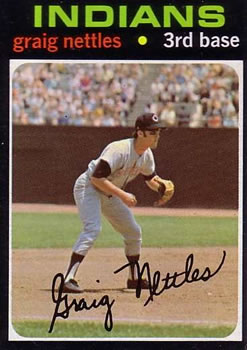 this day, manager Earl Weaver was not throwing one of the Big Three at the Tribe- it was journeyman Jim Hardin. The Indians countered with the lefty McDowell.
this day, manager Earl Weaver was not throwing one of the Big Three at the Tribe- it was journeyman Jim Hardin. The Indians countered with the lefty McDowell.
After Jack Heidemann led off the game by getting hit by a Hardin pitch (attaboy Jack), Graig Nettles grounded into a force at second. Vada Pinson singled to center, moving Nettles to third.
Unsurprisingly, Ray Fosse proceeded to crush a highly satisfying home run to center field. (The guy was a stud, what can you say.) That was it for the scoring in the first inning, although Tony Horton doubled to center before the side was retired.
The Oriole lineup was killer. McDowell surrendered a single through the right side to left fielder Merv Rettenmund to start the game. Second baseman Bobby Grich grounded to short for the force, before Frank Robinson walked. Boog Powell hit an infield single to load the bases. McDowell reared back for something extra- and uncorked a wild pitch to center fielder Paul Blair. 3-1 Tribe after one.
In the second inning, the Tribe was dispatched quickly. McDowell then proceeded to strike out the side (Davey Johnson, Elrod Hendricks and Hardin).
The 3-1 score stood until the bottom of the third. The top of the order for the Orioles went walk-strikeout-hit by pitch-foul pop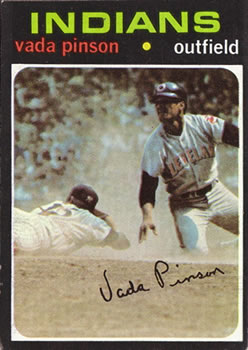 out-walk. (That, in a nutshell, was Sam McDowell.) With two out and the bases loaded, third baseman Brooks Robinson tripled to score all three. Johnson drove him in, and the O’s were now ahead 5-3.
out-walk. (That, in a nutshell, was Sam McDowell.) With two out and the bases loaded, third baseman Brooks Robinson tripled to score all three. Johnson drove him in, and the O’s were now ahead 5-3.
The Tribe answered with a run in the fourth. Tony Horton tripled to right, and Uhlaender promptly singled him home.
Frank Robinson hit a leadoff home run in the bottom of the fifth- and was matched by an Eddie Leon (wow Eddie, what has gotten into you!) homer in the sixth. 6-5 Orioles.
On to the top of the seventh. Pinson reached on a one-out error by Powell. Fosse singled to center, with Pinson stopping at second. After a strikeout by the pinch hitting Hinton, Tony Horton singled to left, scoring Pinson. 6-6 tie. (I have always loved the American League. As I used to tell my smug National League friends: what is so compelling about teams that are built to not hit?)
The Tribe took a Baltimore error, and mixed it with a single, a hit by pitch, a bunt, a walk, a fielder’s choice and a sacrifice fly to score two more runs in the eighth.
Have you been keeping track? Tony Horton walked to the plate to lead off the ninth inning, with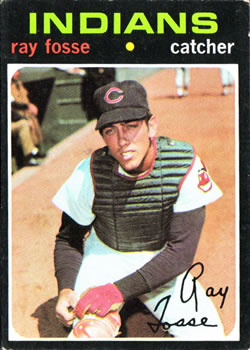 the Tribe ahead by two. He’d already collected a double, a triple and a single. He needed a home run for the ‘cycle’. The ‘cycle’ is an oddity- his earlier three-homer game was much more productive- but baseball fans regard the ‘cycle’ as something special. Horton stepped in against reliever Pete Richert. Home run!! Add another chapter in the story of Tribe slugger Tony Horton. Cleveland went on to win- but only by one run, as pinch hitter Don Buford, Frank Robinson and Powell went walk-single-homer to put a scare into Tribe pitcher and Wooster, Ohio native Dean Chance before the side was retired.
the Tribe ahead by two. He’d already collected a double, a triple and a single. He needed a home run for the ‘cycle’. The ‘cycle’ is an oddity- his earlier three-homer game was much more productive- but baseball fans regard the ‘cycle’ as something special. Horton stepped in against reliever Pete Richert. Home run!! Add another chapter in the story of Tribe slugger Tony Horton. Cleveland went on to win- but only by one run, as pinch hitter Don Buford, Frank Robinson and Powell went walk-single-homer to put a scare into Tribe pitcher and Wooster, Ohio native Dean Chance before the side was retired.
As baseball fans learned in the late 1990s, Tony Horton was unable to handle the pressures of baseball. He apparently was obsessed with succeeding for his father, and no amount of success was good enough. He also was said to have been stung by being traded away from the Red Sox in 1967.
In 1970, he held out for a larger contract through the spring. Tribe manager Alvin Dark (who also apparently had general manager duties) acquired Ken Harrelson (spit) and basically told Horton that if he didn’t take the contract offered to him, Harrelson would play first base. Horton caved, and on the day after he reported to the team, Harrelson suffered a season-ending injury. Horton bemoaned his bad luck. Cleveland fans gave him a very hard time for having held out.
Another notable game involving Tony Horton in 1970 was on June 24, in the Bronx. Yankee pitcher Steve Hamilton occasionally threw an ‘eephus’ pitch, which he called a ‘folly floater’. It was just a pitch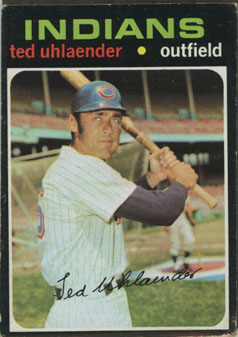 thrown so slowly that it had to be tossed up in the air in order for it to travel far enough to get to home plate. Hamilton threw a floater to Horton, who fouled it out of play. With the crowd going crazy, Hamilton threw another- Horton again popped it up, this time to catcher Thurman Munson for the out. Walking away from the plate, Horton flipped his bat, then his helmet, and crawled the last ten feet or so to the dugout. Writers use this as evidence of the troubled nature of Horton. I side with Nettles: while Horton had his issues coping with self-induced pressure, the crawling was likely just him responding to the situation, playing to the crowd a little.
thrown so slowly that it had to be tossed up in the air in order for it to travel far enough to get to home plate. Hamilton threw a floater to Horton, who fouled it out of play. With the crowd going crazy, Hamilton threw another- Horton again popped it up, this time to catcher Thurman Munson for the out. Walking away from the plate, Horton flipped his bat, then his helmet, and crawled the last ten feet or so to the dugout. Writers use this as evidence of the troubled nature of Horton. I side with Nettles: while Horton had his issues coping with self-induced pressure, the crawling was likely just him responding to the situation, playing to the crowd a little.
Horton’s battles with demons culminated later in 1970, with a suicide attempt in his car at the motel where he was living at the time. The good news is the attempt was unsuccessful, and he appears to have moved on to a better life, out of the public eye and beyond baseball.
I try to avoid the woe-is-Cleveland, God-hates-us, there-is-a-curse stories. One, they tend to not be all that much fun (am I alone in that? Why, for instance, would I ever want to dwell on Beer Night?). More notably, you can find those stories elsewhere. The most noteworthy Tony Horton pieces I have read are found here and here (this one includes a YouTube clip of the crawling episode).
To this old baseball card collector, Tony Horton was a star. He put forth maximum effort (yes, to a fault). And on July 2, 1970, he hit for the cycle against the eventual World Champion Baltimore Orioles.
Thank you for reading.
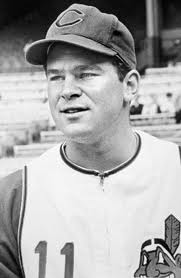

- NBA Announces 2013-2014 Schedule
- Browns Ink Sharknado
- Sharknado A No-Show For Rookie Camp
- Trent Richardson Out Until Training Camp
- Browns Sign Brandon Jackson
- Carrasco Suspended Eight Games
- Browns Add to Wide Receiver Depth with David Nelson
- Browns Need to Learn from Past Draft Mistakes
- Browns Release Chris Gocong and Usama Young
- Browns Missing on Grimes Disappointing, But Not The End
The TCF Forums
- Chris Grant's first 3 drafts
Kingpin74 (Tuesday, January 21 2014 10:13 AM) - The 2014 Offseason Thread
googleeph2 (Tuesday, January 21 2014 9:36 AM) - 2015 Recruiting
furls (Tuesday, January 21 2014 6:57 AM) - Mike Brown
YahooFanChicago (Monday, January 20 2014 11:15 PM) - Movies coming out
HoodooMan (Monday, January 20 2014 9:34 PM) - 2014 Hoops Hockey Hijinx
jpd1224 (Monday, January 20 2014 4:44 PM) - 2014 Recruiting
jclvd_23 (Monday, January 20 2014 2:26 PM) - Wish List - #4 Pick
Hikohadon (Monday, January 20 2014 1:26 PM) - Official- Browns Coach Search/Rumors
OldDawg (Sunday, January 19 2014 6:48 PM) - #1 overall pick Anthony Bennett
TouchEmAllTime (Sunday, January 19 2014 1:28 PM)



